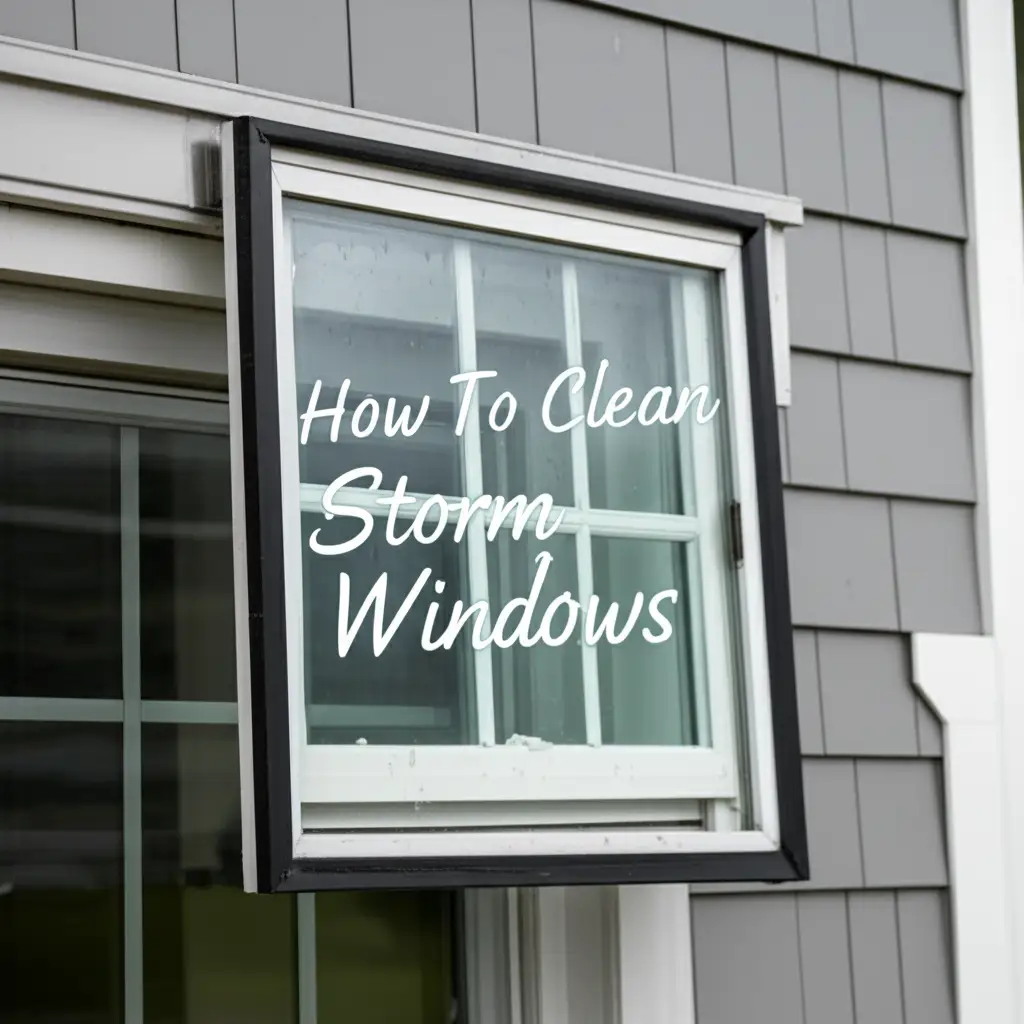· Home Maintenance · 21 min read
How To Clean Storm Windows

Maximize Clarity: How to Clean Storm Windows Effectively
Do your storm windows look hazy? Are they covered in stubborn grime? Many homeowners understand the value of storm windows. These vital barriers protect against weather and improve insulation. Yet, they often gather dirt and dust, blocking natural light and clear views.
Keeping them clean helps your home look its best. It also makes sure they work well. Dirty storm windows can affect your home’s energy efficiency. They might even hide damage to the main window underneath. This guide shows you how to clean storm windows from start to finish. I will cover everything from gathering tools to streak-free finishes. Let us get those windows sparkling.
Takeaway
- Gather all necessary cleaning tools and solutions before starting.
- Prioritize safety, especially when using ladders or handling glass.
- Remove storm windows carefully, marking them for correct reinstallation.
- Clean both the glass panes and the frames thoroughly for best results.
- Dry components completely before reinstalling to prevent future issues.
To clean storm windows, carefully remove them from their frames. Wash the glass and frames with a mild detergent and water mixture. Use a soft brush or cloth to remove dirt. Rinse thoroughly with clean water. Dry them completely before reinstalling to achieve streak-free clarity.
Why Cleaning Storm Windows Matters
Cleaning your storm windows is more than just about appearances. It plays a big part in your home’s overall health and efficiency. These windows are the first line of defense against outside elements. Over time, they collect a lot of dirt. This buildup reduces light and makes your views hazy.
Regular cleaning helps them last longer. It also ensures they perform their job well. I find that a clean storm window improves my home’s comfort. It makes my living spaces brighter and more inviting.
Enhancing Home Efficiency and Longevity
Storm windows add an extra layer of insulation to your home. They trap air between the main window and themselves. This air pocket slows heat transfer. When storm windows get dirty, their ability to insulate can lessen. Layers of dust and grime absorb more heat in summer. They block more warmth from coming in during winter.
Cleaning them removes this insulating barrier. It allows the windows to work as intended. This helps lower your energy bills. It also extends the lifespan of both your storm windows and the primary windows. Regular cleaning prevents dirt from etching into the glass. It also stops corrosion on the frames. I believe this simple task adds years to your windows.
When to Clean Your Storm Windows
The best time to clean storm windows is usually twice a year. I suggest doing it in the spring. This prepares your home for warmer months. It removes winter grime. A fall cleaning is also good. It makes them ready for cold weather.
Some people remove their storm windows completely for summer storage. If you do this, clean them before putting them away. This prevents dirt from sitting on the glass for months. It also ensures they are clean when you reinstall them in the fall. I aim for clear windows all year round.
Gathering Your Essential Tools and Cleaning Solutions
Before I start cleaning, I always make sure I have everything I need. This prevents interruptions and makes the job smoother. Cleaning storm windows properly requires more than just a spray bottle. You need the right tools to handle different parts of the window.
Having all your supplies ready saves time. It also ensures a safer cleaning process. I like to lay everything out in one spot. This way, I can easily grab what I need as I go.
Must-Have Tools for the Job
Here is a list of tools I find essential:
- Two Large Buckets: One for soapy water, one for rinse water.
- Soft Bristle Brush or Sponge: For scrubbing frames and general dirt.
- Microfiber Cloths: For drying and polishing glass, and for wiping frames.
- Squeegee: A good quality squeegee with a sharp rubber blade is crucial for streak-free windows.
- Ladder: A sturdy ladder is necessary for reaching upper windows. Always ensure it is placed on a stable surface.
- Gloves: To protect your hands from cleaning solutions and dirt.
- Safety Glasses: To shield your eyes from splashes.
- Garden Hose with Spray Nozzle: For rinsing large sections or stubborn dirt.
- Small Pry Bar or Flathead Screwdriver: For gently removing stubborn clips or latches if needed.
- Marking Pen or Labels: To label each window for easy reinstallation.
These tools help me tackle any level of dirt. They also keep me safe. Investing in good tools makes the job easier and more effective.
Effective Cleaning Solutions
You have a few options for cleaning solutions. I often use a simple, homemade mix. It works very well for most dirt.
Homemade Solution:
- Warm Water: Fills one bucket.
- Dish Soap: A few drops of a mild dish soap are enough. Avoid too much foam.
- White Vinegar: Add a quarter to half a cup of white vinegar per gallon of water. Vinegar helps cut through grime and prevents streaks.
- Optional: Rubbing Alcohol: A splash (about a quarter cup per gallon) can help windows dry faster and leave them extra shiny.
Commercial Window Cleaner:
If you prefer, a good quality commercial window cleaner works too. Look for formulas designed for outdoor use or heavy-duty cleaning. Make sure it is safe for all window materials. I personally find the homemade solution just as effective. It is also more economical.
Regardless of your choice, always mix the solution properly. Do not use harsh chemicals. They can damage window frames or finishes. I always test a small, hidden area first. This confirms the solution is safe for my specific windows. For how to clean windows without streaks, the right solution and technique are key.
The Step-by-Step Process for Removing Storm Windows
Removing storm windows can seem daunting. With a careful approach, it is a straightforward task. This step is often necessary for thorough cleaning. It allows you to clean both sides of the glass and the frames properly. I always emphasize safety during this stage.
Each window type might have slightly different removal mechanisms. Take your time to understand how yours works. Rushing can lead to damage or injury. My goal is always a safe and successful removal.
Prioritizing Safety During Removal
Safety is my top concern when working with storm windows. They can be heavy and awkward. Glass can break. Always follow these guidelines:
- Wear Gloves and Safety Glasses: Protect your hands from sharp edges or splinters. Protect your eyes from dust or debris.
- Use a Stable Ladder: If working on upper floors, ensure your ladder is on solid, level ground. Have someone hold the ladder if possible. Do not overreach. Move the ladder instead.
- Work Slowly and Deliberately: Do not rush. Take your time with each latch or fastener.
- Get Help for Large Windows: If a storm window is very large or heavy, ask a friend or family member for assistance. Two people can lift and maneuver it much more safely.
I always double-check my setup. This helps me feel secure before I even touch the window.
Marking Windows for Reinstallation
This step is incredibly important. Storm windows are often custom-fitted to their openings. They might not fit perfectly if you put them back in the wrong spot. I learned this the hard way years ago. Now, I always mark them.
- Choose a System: Use a numbering system or simple labels. For example, “LR1” for Living Room Window 1, “K-UL” for Kitchen Upper Left.
- Use a Permanent Marker or Labels: Write directly on the frame in a hidden spot. Or, attach a piece of masking tape with your label. I prefer writing directly on the frame for permanence.
- Mark Both the Window and the Opening: It is also helpful to put a small, corresponding mark on the window frame itself. This helps confirm the match.
This simple step saves a lot of frustration later. It ensures a smooth reinstallation process.
Techniques for Safe Removal
Once you are set up and marked, you can begin removal. Most storm windows use one of a few common fastening systems.
- Identify Fasteners: Look for clips, latches, hooks, or screws around the perimeter of the storm window.
- Release Latches/Clips:
- Many older storm windows have metal clips that swivel or slide. Turn them to release the window.
- Some have spring-loaded latches. Push them in or slide them to unlock.
- Newer storm windows might have tracks. You may need to lift the window slightly to clear the bottom track. Then pull the bottom out.
- Support the Window: As you release the fasteners, hold the window firmly. It might want to fall inward or outward.
- Careful Extraction: Gently pull the storm window out of its frame. If it is stubborn, do not force it. Check for any missed fasteners. You may need to gently pry the frame if it is stuck.
- Lower to a Safe Place: Once free, carefully lower the window. If working from a ladder, have someone below to take it. Or, slowly back down the ladder while holding the window securely. Place it on a padded surface or a drop cloth. This prevents scratches or breaks.
Remember, each storm window is unique. Spend a moment observing its mechanism. This careful approach prevents damage to your windows or home.
Deep Cleaning Techniques for Storm Window Panes
Once the storm windows are removed, the real cleaning begins. This is where you can get into every corner. I find that proper technique makes all the difference for a truly clean, streak-free pane. My focus here is on thoroughness and efficiency.
Start with the dirtiest parts first. This usually means the outside surface. Then move to the inside. Always work from top to bottom. This ensures dirty water does not run over already clean areas.
Pre-Cleaning: Tackling Frames and Sills
Before touching the glass, clean the frames and sills. These parts collect the most grime, dust, and debris. If you clean the glass first, dirt from the frames will inevitably drip onto your clean panes.
- Brush Away Loose Debris: Use a dry brush or a vacuum cleaner with a brush attachment. Remove loose dirt, cobwebs, and insects from the frames and sills. Pay attention to corners and tracks.
- Wash Frames: Dip a soft brush or sponge into your soapy cleaning solution. Scrub the entire frame. For wooden frames, be gentle. For aluminum or vinyl, you can apply a bit more pressure.
- Rinse Frames: Rinse the frames thoroughly with clean water. You can use a hose for outdoor frames or a clean, wet cloth for indoor ones. Make sure no soap residue remains.
- Wipe Dry: Use a clean microfiber cloth to wipe the frames dry. This prevents water spots and prepares them for the glass cleaning.
This step sets the stage for perfectly clean glass. It also gives you a chance to inspect the frames for any damage.
Cleaning the Glass: Removing Dirt and Grime
Now, move on to the glass panes. This is the most rewarding part. Seeing the dirt disappear reveals crystal-clear views.
- Wet the Pane: Liberally spray or wipe your cleaning solution onto the entire glass pane. Make sure the surface is saturated. This helps loosen dirt and grime. For how to clean dirty windows, this initial wetting is critical.
- Scrub Stubborn Spots: Use your soft brush or sponge to gently scrub any stubborn spots. This includes bird droppings, hardened dirt, or pollen. Be careful not to use abrasive materials that could scratch the glass.
- Use a Squeegee for Streak-Free Results: This is where the magic happens.
- Technique: Start at the top corner of the pane. Place the squeegee blade firmly against the glass. Pull it across in a straight, overlapping stroke. Overlap each stroke by about an inch. You can use horizontal or vertical strokes.
- Clean Blade: After each stroke, wipe the squeegee blade clean with a dry microfiber cloth. This prevents streaks from transferring dirt back to the glass.
- Angles: For the best results, hold the squeegee at a slight angle (about 45 degrees) to the glass.
- Edges: Use a clean, dry microfiber cloth to wipe away any water lines left at the edges of the pane.
I personally find the squeegee method the fastest and most effective. It gives me consistent, streak-free results every time.
Addressing Specific Stains and Issues
Sometimes, general cleaning is not enough. You might encounter specific stains that need targeted treatment.
- Hard Water Spots: These leave a cloudy, mineral residue. For how to clean hard water off windows, mix equal parts white vinegar and water. Apply it to the spots. Let it sit for a few minutes. Then scrub with a soft cloth or fine steel wool (0000 grade only, very gently). Rinse well.
- Paint Splatters: If you have small paint splatters, you can carefully scrape them off. Use a plastic scraper or a razor blade held at a very shallow angle. Be extremely cautious not to scratch the glass. For larger paint spots, refer to guides on how to clean paint off windows.
- Cloudy or Foggy Panes (Inside): If your storm windows look cloudy or foggy between the panes, this usually indicates a seal failure. This cannot be cleaned. The unit likely needs repair or replacement. However, if the cloudiness is on the surface, normal cleaning should resolve it. For information on surface cloudiness, check how to clean cloudy windows and how to clean foggy windows.
- Adhesive Residue: For sticky residues from tape or old labels, use rubbing alcohol or a commercial adhesive remover. Apply it to a cloth, rub the residue, and then clean the area normally.
Always test specialized cleaners in an inconspicuous area first. This prevents damage to the window or frame. My goal is to always achieve a perfect finish.
Cleaning Storm Window Screens and Frames
Cleaning the glass panes is only half the job. Storm windows often include screens. These screens also collect a lot of dust, pollen, and debris. Neglecting them defeats the purpose of clean windows. They will simply blow dirt back onto your fresh glass. I always include the screens and the window frames in my cleaning routine.
The frames of the storm windows themselves need attention too. They can harbor dirt and even rust. A complete clean includes all components.
Refreshing Storm Window Screens
Screens are designed to keep insects out. This means they are great at trapping dust and pollen. Cleaning them is relatively easy.
- Remove Loose Debris: Lay the screen flat on a clean surface or stand it upright against a wall. Use a soft brush or a vacuum cleaner with a brush attachment. Gently brush or vacuum away loose dirt, cobwebs, and dead insects from both sides of the screen.
- Wash with Mild Soap and Water:
- Mix a small amount of mild dish soap with warm water in a bucket.
- Dip a soft sponge or brush into the soapy water.
- Gently scrub the screen from top to bottom. Do not press too hard. You want to avoid stretching or damaging the mesh.
- Rinse Thoroughly: Use a garden hose with a gentle spray nozzle. Rinse the screen completely. Ensure all soap residue is gone. Soap left behind can attract more dirt.
- Allow to Air Dry: Shake off excess water. Prop the screen up or lay it flat in a sunny, well-ventilated area. Let it air dry completely before proceeding. Do not reinstall a wet screen. It can lead to mold or mildew growth.
I find that a clean screen dramatically improves air circulation when the windows are open. It also makes the views much clearer.
Cleaning the Frame Material
Storm window frames come in various materials, each requiring slightly different care. Common materials include wood, aluminum, and vinyl.
- Wood Frames:
- Cleaning: Use a damp cloth with a mild soap solution. Gently wipe down the frame. Avoid saturating the wood.
- Inspection: Check for peeling paint, rot, or mold. Address these issues promptly to prevent further damage. You might need to sand, prime, and repaint or seal areas.
- Drying: Dry wood frames immediately with a clean cloth. Moisture can cause warping or rot.
- Aluminum Frames:
- Cleaning: These are durable. Use your general window cleaning solution and a soft brush or sponge. Scrub away dirt, oxidation, or grime.
- Rinsing: Rinse well with clean water. Aluminum can show water spots if not rinsed properly.
- Addressing Oxidation/Rust: If you see white powdery oxidation or light rust spots, you can gently scrub them with a non-abrasive pad. For more severe issues, specialized aluminum cleaners are available. However, prevention through regular cleaning is best.
- Vinyl Frames:
- Cleaning: Vinyl is low maintenance. A simple solution of mild soap and water is perfect. Wipe down with a sponge or cloth. For how to clean vinyl windows in sunroom or storm windows, avoid abrasive cleaners which can scratch the surface.
- Stains: For stubborn stains on vinyl, a paste of baking soda and water can be effective. Apply, let sit, then gently scrub and rinse.
No matter the material, ensure the frames are clean and dry before reinstallation. This prevents dirt from transferring back to your freshly cleaned glass. It also helps preserve the material for years to come. I believe careful frame cleaning makes the whole window look better.
Drying, Inspection, and Reinstallation Tips
You have done all the hard work of cleaning. Now comes the crucial final stage: drying, inspecting, and putting everything back. This part is just as important as the cleaning itself. Improper drying can lead to water spots or mold. Poor reinstallation can compromise the window’s seal and efficiency. I pay close attention to these steps to ensure my hard work lasts.
My goal is not just a clean window but also one that performs optimally. This means ensuring every part is dry and properly fitted.
Ensuring Components are Completely Dry
This step is non-negotiable. Reinstalling wet storm windows can lead to several problems:
- Water Spots: Even after squeegeeing, tiny drops of water can remain. If these dry on the glass after reinstallation, they will leave visible spots.
- Mold and Mildew: Trapped moisture between the storm window and the primary window creates a perfect environment for mold and mildew. This is unhealthy and difficult to remove once it starts.
- Damage to Frames: For wooden storm windows, trapped moisture can lead to rot or warping. For metal frames, it can accelerate corrosion.
Drying Method:
- Air Dry: The best way to dry storm windows and screens is to let them air dry completely. Place them in a well-ventilated area, preferably in sunlight. Propping them up allows air to circulate around all surfaces.
- Wipe Down: Use clean, dry microfiber cloths to wipe down frames, sills, and any remaining moisture on the glass. I often go over the glass one more time with a fresh, dry cloth.
Give them ample time to dry. Patience here saves a lot of headaches later. I usually let them sit for at least a few hours, or even overnight, if possible.
Inspecting for Damage and Maintenance Opportunities
While the windows are out, it is the perfect time for a thorough inspection. This allows you to catch minor issues before they become major problems.
- Check Glass for Cracks or Chips: Look closely for any damage to the glass panes. Small cracks can grow over time. Address them professionally if found.
- Inspect Frames: Examine the storm window frames for warping, rot (on wood), corrosion (on metal), or cracks (on vinyl). Are the joints tight?
- Weatherstripping and Sealing: Look at the weatherstripping around the edges of the storm window. Is it brittle, torn, or missing? This material is crucial for creating a tight seal. Check the caulk around the primary window frame. Is it cracked, peeling, or deteriorated?
- Hardware: Inspect latches, clips, hinges, and screws. Are they loose, bent, or rusty?
- Screens: Check screens for tears, holes, or sagging.
This inspection allows you to perform minor maintenance now. It prevents issues that could affect your home’s efficiency. I replace worn weatherstripping immediately. It is a cheap fix that makes a big difference.
Reinstallation Process
Reinstalling the storm windows requires precision. This is where your labeling system from earlier becomes invaluable.
- Match Windows to Openings: Refer to your labels. Ensure you are putting each storm window back into its original opening.
- Clean the Primary Window Frame: Before putting the storm window back, quickly wipe down the area of the primary window frame where the storm window sits. Remove any dust or debris that might have accumulated.
- Lift and Align: Carefully lift the storm window. Align it with the tracks or mounting points in the window frame. This can be tricky, especially with larger windows. Remember to get help if needed.
- Secure Fasteners: Once aligned, engage the clips, latches, or screws that hold the storm window in place. Make sure they are secure. The window should feel snug and not wobble.
- Test the Seal: After reinstallation, gently push on the storm window from the inside. It should not move freely. Feel for any drafts around the edges. If you find drafts, check the weatherstripping or adjust the fasteners.
A properly reinstalled storm window provides maximum protection and efficiency. This final step completes the entire cleaning and maintenance process. I feel a sense of accomplishment when I see my clear, secure storm windows back in place.
Advanced Tips for Stubborn Stains and Long-Term Care
Even with regular cleaning, some issues can pop up. Stubborn stains sometimes require extra effort. Long-term care ensures your storm windows stay in top condition. I have learned a few tricks over the years for these more challenging situations. My goal is to keep windows looking good and functioning well for as long as possible.
These advanced tips help you tackle specific problems. They also offer advice for proactive maintenance.
Dealing with Stubborn Stains
Regular cleaning handles most dirt. But some stains cling on.
- Mold and Mildew:
- Cause: Often found on frames or around seals in damp conditions.
- Solution: Mix equal parts white vinegar and water. For tougher mold, use a solution of 1 part bleach to 10 parts water. Apply to the affected area with a cloth or sponge. Let it sit for 10-15 minutes. Scrub gently with a brush. Rinse thoroughly with clean water. Always wear gloves and ensure good ventilation when using bleach.
- Prevention: Ensure proper drying after cleaning. Improve air circulation around windows.
- Adhesive or Old Caulk Residue:
- Cause: Leftover sticky substances from old tape, labels, or deteriorated caulk.
- Solution: For adhesives, try rubbing alcohol or mineral spirits on a cloth. For caulk, carefully scrape away as much as possible with a plastic scraper. Then use a specialized caulk remover or mineral spirits to soften and remove any remaining residue. Always test on an inconspicuous area first.
- Oxidation (on Aluminum Frames):
- Cause: A white, powdery film that forms on aluminum due to exposure to air and moisture.
- Solution: For light oxidation, a paste of baking soda and water, or fine steel wool (0000 grade) with a mild abrasive cleaner, can work. Rub gently in the direction of the grain. For heavy oxidation, specialized aluminum polish or cleaner may be needed.
- Scratches:
- Cause: Accidental scrapes from tools or debris.
- Solution: Minor scratches on glass can sometimes be buffed out with a glass scratch repair kit. These kits use cerium oxide. For deep scratches, the glass pane usually needs replacement. For how to clean ceramic tinted windows, be extra careful as these might scratch more easily.
Patience is key when dealing with stubborn stains. Do not use harsh chemicals or abrasive tools that could cause more damage.
Protecting Windows During Off-Season Storage
If you remove your storm windows for the warmer months, proper storage is vital. This prevents damage and keeps them cleaner for longer.
- Clean Before Storage: Always clean your storm windows thoroughly before putting them away. This prevents dirt from etching into the glass or causing long-term damage.
- Store Vertically: Store windows upright if possible. Lean them against a wall. This reduces the risk of warping or bending. If you must stack them horizontally, place padding (blankets, cardboard) between each window.
- Protect from Elements: Store them in a dry, cool place. A garage, basement, or shed is ideal. Avoid extreme temperature fluctuations. Keep them out of direct sunlight.
- Label Clearly: Reinforce your labels for easy identification next season.
Proper storage saves you work next time. It also extends the life of your storm windows. I always find it easier to reinstall clean, well-preserved windows.
Establishing a Regular Maintenance Schedule
Consistency is key for long-term window health. I recommend establishing a routine for storm window care.
- Seasonal Cleaning: Plan for a full cleaning twice a year. Spring cleaning removes winter grime. Fall cleaning prepares them for cold weather.
- Mid-Season Spot Checks: Quickly inspect your storm windows once a month. Look for any new dirt, debris, or obvious issues. Address small problems before they grow.
- Post-Storm Inspection: After heavy rain, high winds, or a major storm, quickly check your windows. Look for dislodged screens, broken glass, or compromised seals.
- Frame and Seal Checks: During your twice-yearly cleaning, thoroughly inspect weatherstripping and caulk. Replace or repair as needed.
A proactive approach to maintenance saves you time and money. It also keeps your storm windows looking their best. I enjoy knowing my home is well-maintained.
Frequently Asked Questions
How often should I clean storm windows?
I recommend cleaning storm windows at least twice a year. A spring cleaning removes winter grime and prepares them for warmer weather. A fall cleaning gets them ready for winter. If you live in a dusty area, or near pollen-heavy trees, more frequent cleaning might be helpful. I find this schedule keeps my windows clear and efficient.
Can I clean storm windows without removing them?
Yes, you can clean storm windows without removing them, but it is less thorough. You can clean the accessible exterior and interior surfaces. Use a squeegee or microfiber cloth with your cleaning solution. This method is good for quick touch-ups. For a deep clean, and to clean both sides of the glass, I always advise removing them. This also allows you to clean the frames and screens properly.
What’s the best cleaning solution for storm windows?
The best cleaning solution is often a simple one. I use a mix of warm water, a few drops of mild dish soap, and about a quarter to half a cup of white vinegar
- storm window cleaning
- window cleaning tips
- home efficiency
- seasonal cleaning
- streak-free windows




